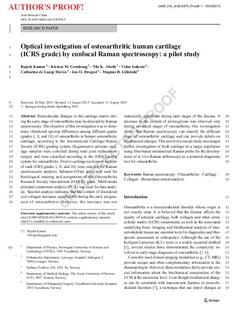| dc.contributor.author | Kumar, Rajesh | |
| dc.contributor.author | Grønhaug, Kirsten Marie | |
| dc.contributor.author | Afseth, Nils Kristian | |
| dc.contributor.author | Isaksen, vidar | |
| dc.contributor.author | Davies, Catharina de Lange | |
| dc.contributor.author | Drogset, Jon Olav | |
| dc.contributor.author | Lilledahl, Magnus Borstad | |
| dc.date.accessioned | 2017-11-30T09:28:40Z | |
| dc.date.available | 2017-11-30T09:28:40Z | |
| dc.date.created | 2015-10-22T10:07:40Z | |
| dc.date.issued | 2015 | |
| dc.identifier.citation | Analytical and Bioanalytical Chemistry. 2015, 407 (26), 8067-8077. | nb_NO |
| dc.identifier.issn | 1618-2642 | |
| dc.identifier.uri | http://hdl.handle.net/11250/2468598 | |
| dc.description.abstract | Biomolecular changes in the cartilage matrix during the early stage of osteoarthritis may be detected by Raman spectroscopy. The objective of this investigation was to determine vibrational spectral differences among different grades (grades I, II, and III) of osteoarthritis in human osteoarthritic cartilage, which was classified according to the International Cartilage Repair Society (ICRS) grading system. Degenerative articular cartilage samples were collected during total joint replacement surgery and were classified according to the ICRS grading system for osteoarthritis. Twelve cartilage sections (4 sections of each ICRS grades I, II, and III) were selected for Raman spectroscopic analysis. Safranin-O/Fast green was used for histological staining and assignment of the Osteoarthritis Research Society International (OARSI)grade. Multivariate principal component analysis (PCA) was used for data analysis. Spectral analysis indicates that the content of disordered coil collagen increases significantly during the early progression of osteoarthritis. However, the increase was not statistically significant during later stages of the disease. A decrease in the content of proteoglycan was observed only during advanced stages of osteoarthritis. Our investigation shows that Raman spectroscopy can classify the different stage of osteoarthritic cartilage and can provide details on biochemical changes. This proof-of-concept study encourages further investigation of fresh cartilage on a larger population using fiber-based miniaturized Raman probe for the Development of in vivo Raman arthroscopy as a potential diagnostic tool for osteoarthritis. | nb_NO |
| dc.language.iso | eng | nb_NO |
| dc.publisher | Springer Verlag | nb_NO |
| dc.title | Optical investigation of osteoarthritic human cartilage (ICRS grade) by confocal Raman spectroscopy: a pilot study | nb_NO |
| dc.type | Journal article | nb_NO |
| dc.type | Peer reviewed | nb_NO |
| dc.description.version | acceptedVersion | nb_NO |
| dc.source.pagenumber | 8067-8077 | nb_NO |
| dc.source.volume | 407 | nb_NO |
| dc.source.journal | Analytical and Bioanalytical Chemistry | nb_NO |
| dc.source.issue | 26 | nb_NO |
| dc.identifier.doi | 10.1007/s00216-015-8979-5 | |
| dc.identifier.cristin | 1282591 | |
| dc.relation.project | Regionale forskningsfond Midt-Norge: 46084300 | nb_NO |
| dc.relation.project | Nofima AS: 201309 | nb_NO |
| dc.relation.project | Norges forskningsråd: 225347 | nb_NO |
| dc.description.localcode | © Springer Verlag. This is the authors' accepted and refereed manuscript to the article. The final publication is available at https://link.springer.com/article/10.1007%2Fs00216-015-8979-5 | nb_NO |
| cristin.unitcode | 194,66,20,0 | |
| cristin.unitname | Institutt for fysikk | |
| cristin.ispublished | true | |
| cristin.fulltext | postprint | |
| cristin.qualitycode | 1 | |
